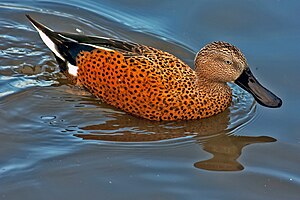Fox Shovel
| Fox Shovel | ||||||||||||
|---|---|---|---|---|---|---|---|---|---|---|---|---|

Male of the Fox Shovel ( Spatula platalea ) |
||||||||||||
| Systematics | ||||||||||||
|
||||||||||||
| Scientific name | ||||||||||||
| Spatula platalea | ||||||||||||
| ( Vieillot , 1816) |
The Fox Shoveler ( Spatula platalea , Syn . : Anas platalea ), also known as the Argentine Shoveler or South American Shoveler , is a species from the duck family .
Systematics
The ringed teal is the smallest of the spoonbills, which include the European Shoveler the Australian Shoveler and the South African Shoveler count. Like these, the shoveler also has a spoon-like widened beak, which has developed into a strainer through the arrangement of fine lamellae. The fox shovel is considered to be the link to cinnamon , as it shares some similarities with it.
Appearance
Fox shovels show a pronounced sexual dimorphism . The females are generally brownish-yellow in color and have black-brown markings on their plumage. In the male birds, on the other hand, the head and neck are colored light brownish to gray with a black line drawing. The body plumage, however, is held in a reddish brown, which is evenly speckled dark brown.
Distribution area
The fox shovel is found on the southern South American continent ; the distribution area stretches from Buenos Aires in the north to Tierra del Fuego in the south. With 8 to 16 breeding pairs, the fox shovel is also represented on the Falkland Islands and is therefore part of the subantarctic avifauna. It is most common in the coastal regions of Argentina . Their distribution area is almost identical to that of the Argentine cinnamon, a subspecies of the cinnamon .
Way of life
During the breeding season, the birds live in pairs in the brackish and sweet shallow waters of the open landscape. The nests are built on dry ground near the water. The birds breed from September to November. The clutch includes six to eight cream-colored to greenish colored eggs. The chicks hatch after 25 days and reach sexual maturity towards the end of their first year of life. There are not very many field observations of this species, but it is suspected that the drake is involved in chick management.
The food is taken up from the water and consists of parts of aquatic plants as well as small organisms and algae. The proportion of animal proteins in the diet predominates.
Keeping as ornamental poultry
Fox bucket ducks were first imported to Europe in 1932 and bred for the first time in 1934. After the end of World War II, it was mainly the British Wildfowl Trust that successfully bred this species of duck. Since the 1960s, this species has been kept by both private breeders and zoos . This can lead to hybridization with other species of shoveler if they are kept in an enclosure.
supporting documents
literature
- Janet Kear (Ed.): Ducks, Geese and Swans. Oxford University Press, 2005, ISBN 0-19-854645-9 .
- Hartmut Kolbe: The world's ducks. Ulmer Verlag, 1999, ISBN 3-8001-7442-1 ,
- Robin Woods, Anne Woods: Atlas of Breeding Birds of the Falkland Islands. Anthony Nelson, Shorpshire 1997, ISBN 0-904614-60-3 .
Web links
- Spatula platalea in the endangered Red List species the IUCN 2008. Posted by: BirdLife International, 2008. Accessed on December 23 of 2008.
- Videos, photos and sound recordings of Anas platalea in the Internet Bird Collection
Single receipts
- ↑ Wood, p. 98.

